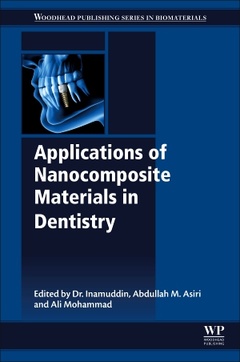Description
Applications of Nanocomposite Materials in Dentistry
Woodhead Publishing Series in Biomaterials Series
Coordinators: Asiri Abdullah M., Inamuddin , Mohammad Ali
Language: English
Subjects for Applications of Nanocomposite Materials in Dentistry:
364 p. · 15x22.8 cm · Paperback
Description
/li>Contents
/li>Readership
/li>Biography
/li>Comment
/li>
Applications of Nanocomposite Materials in Dentistry presents the study and developments of nano-composite materials for dental applications. Special emphasis is given to the issues related to dental bone regeneration using various types of nano-composite materials, issues of dental failure, antibacterial properties and dental implants. Topics are systematically arranged so that layman can also understand the fundamentals and applications of dental nanocomposites. The book offers a powerful source of exploration on the preparation, characteristics and specific uses of composites in the fields of applied chemistry and medical sciences.
2. Calcium fluoride based dental nanocomposites
3. Carbon nanocomposites for implant dentistry and bone tissue engineering
4. Carbon nanotube for dental implants
5. Degradation and failure of dental composite materials
6. Hydroxyapatite composites for dentistry
7. Hydroxyapatite/collagen composite materials for dentistry
8. Nanocomposite restorative materials for dental caries management
9. Nanocomposites and nano-ionomers for orthodontic bracket bonding
10. Nanocomposites: Present, past and future of dentistry
11. Nanotechnology in dentistry
12. Polymer composites for dental fillings
13. Material Selection for Single Tooth Crown Restorations
14. Remineralization and antibacterial capabilities of resin-based dental nanocomposites
15. Titanium based nanocomposite materials for dental implant systems
16. Mechanical stability of dental materials
17. Nano composite for bone and cartilage regeneration
18. Resin composites for restoration of posterior teeth
Scientists, engineers, industrial experts, Ph.D. students and master students in the field of biochemical engineering, materials chemistry, medical industry such as dentistry & orthopaedic and pharmaceutical chemistry
Inamuddin is an assistant professor at the Department of Applied Chemistry, Zakir Husain College of Engineering and Technology, Faculty of Engineering and Technology, Aligarh Muslim University, Aligarh, India. He has extensive research experience in multidisciplinary fields of analytical chemistry, materials chemistry, electrochemistry, renewable energy, and environmental science. He has worked on different research projects funded by various government agencies and universities and is the recipient of awards, including the Fast-Track Young Scientist Award and the Young Researcher of the Year Award 2020 of the university. He has published about 189 research articles in various international scientific journals, 18 book chapters, and 144 edited books with multiple well-known pu
- Offers an historical overview of composites materials and their dentistry applications
- Outlines the role of nanocomposites and nanotechnology in dentistry
- Discusses the properties of nanocomposites for dental grafting, implants and bone tissues




